2004 FORD EXPLORER light
[x] Cancel search: lightPage 259 of 296
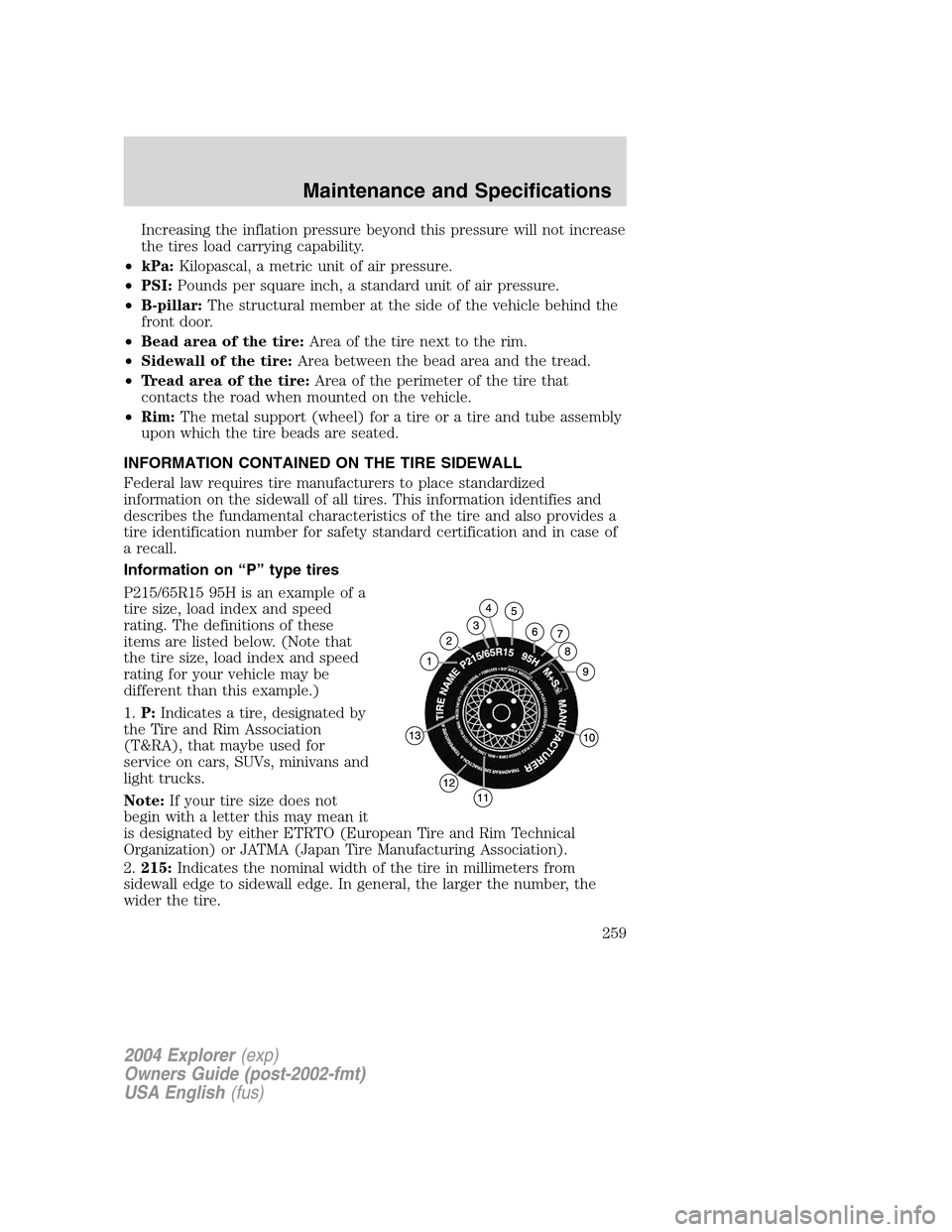
Increasing the inflation pressure beyond this pressure will not increase
the tires load carrying capability.
•kPa:Kilopascal, a metric unit of air pressure.
•PSI:Pounds per square inch, a standard unit of air pressure.
•B-pillar:The structural member at the side of the vehicle behind the
front door.
•Bead area of the tire:Area of the tire next to the rim.
•Sidewall of the tire:Area between the bead area and the tread.
•Tread area of the tire:Area of the perimeter of the tire that
contacts the road when mounted on the vehicle.
•Rim:The metal support (wheel) for a tire or a tire and tube assembly
upon which the tire beads are seated.
INFORMATION CONTAINED ON THE TIRE SIDEWALL
Federal law requires tire manufacturers to place standardized
information on the sidewall of all tires. This information identifies and
describes the fundamental characteristics of the tire and also provides a
tire identification number for safety standard certification and in case of
a recall.
Information on “P” type tires
P215/65R15 95H is an example of a
tire size, load index and speed
rating. The definitions of these
items are listed below. (Note that
the tire size, load index and speed
rating for your vehicle may be
different than this example.)
1.P:Indicates a tire, designated by
the Tire and Rim Association
(T&RA), that maybe used for
service on cars, SUVs, minivans and
light trucks.
Note:If your tire size does not
begin with a letter this may mean it
is designated by either ETRTO (European Tire and Rim Technical
Organization) or JATMA (Japan Tire Manufacturing Association).
2.215:Indicates the nominal width of the tire in millimeters from
sidewall edge to sidewall edge. In general, the larger the number, the
wider the tire.
2004 Explorer(exp)
Owners Guide (post-2002-fmt)
USA English(fus)
Maintenance and Specifications
259
Page 262 of 296
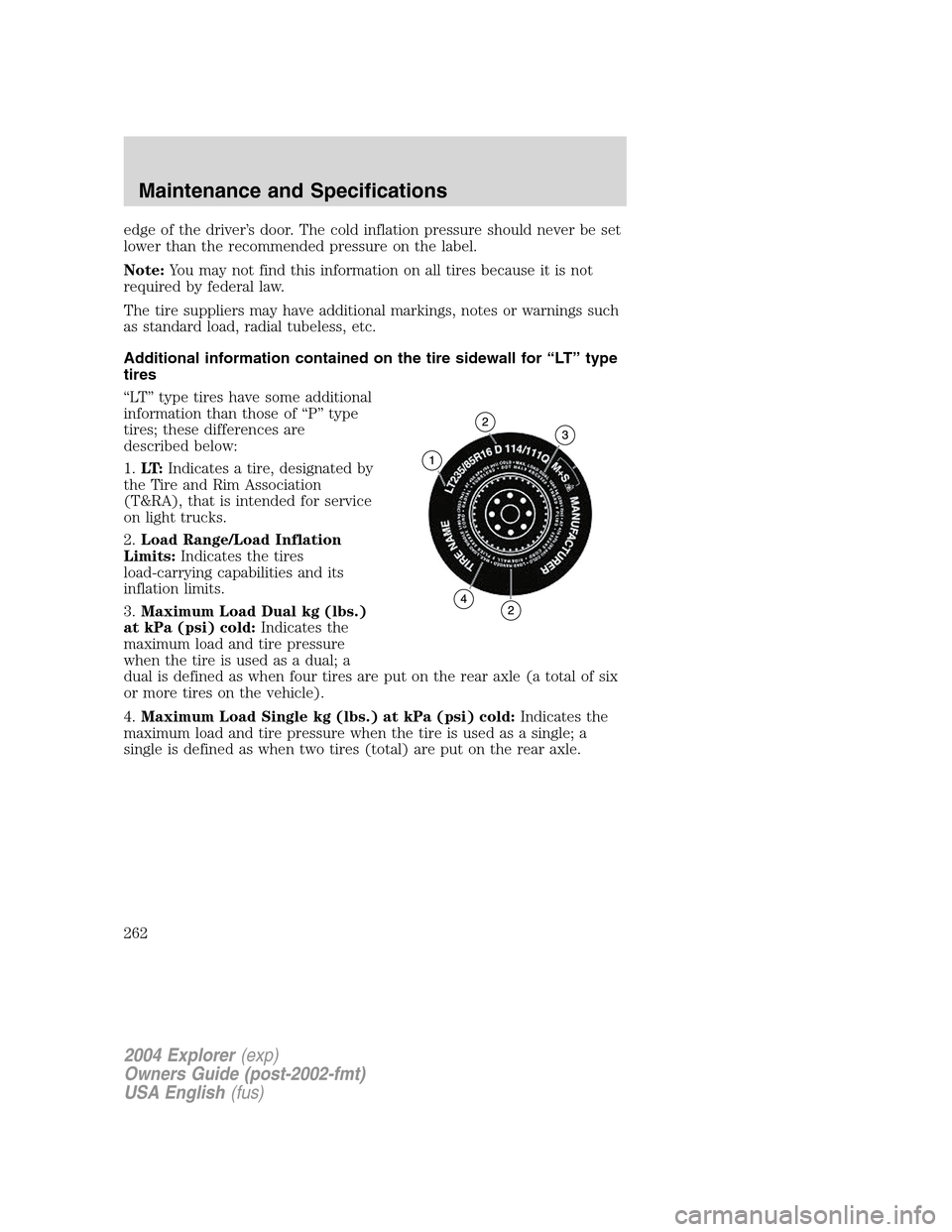
edge of the driver’s door. The cold inflation pressure should never be set
lower than the recommended pressure on the label.
Note:You may not find this information on all tires because it is not
required by federal law.
The tire suppliers may have additional markings, notes or warnings such
as standard load, radial tubeless, etc.
Additional information contained on the tire sidewall for “LT” type
tires
“LT” type tires have some additional
information than those of “P” type
tires; these differences are
described below:
1.LT:Indicates a tire, designated by
the Tire and Rim Association
(T&RA), that is intended for service
on light trucks.
2.Load Range/Load Inflation
Limits:Indicates the tires
load-carrying capabilities and its
inflation limits.
3.Maximum Load Dual kg (lbs.)
at kPa (psi) cold:Indicates the
maximum load and tire pressure
when the tire is used as a dual; a
dual is defined as when four tires are put on the rear axle (a total of six
or more tires on the vehicle).
4.Maximum Load Single kg (lbs.) at kPa (psi) cold:Indicates the
maximum load and tire pressure when the tire is used as a single; a
single is defined as when two tires (total) are put on the rear axle.
2004 Explorer(exp)
Owners Guide (post-2002-fmt)
USA English(fus)
Maintenance and Specifications
262
Page 263 of 296
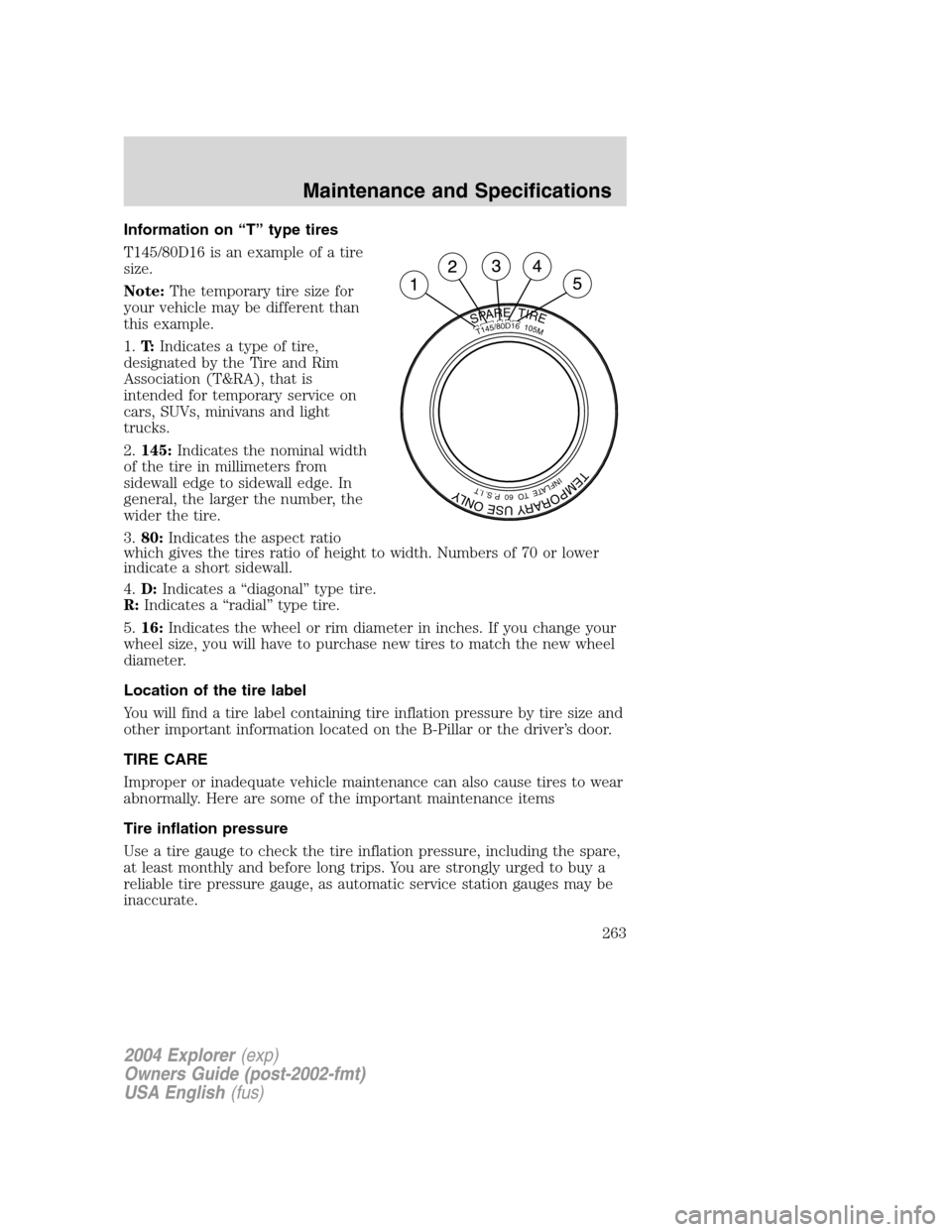
Information on “T” type tires
T145/80D16 is an example of a tire
size.
Note:The temporary tire size for
your vehicle may be different than
this example.
1.T:Indicates a type of tire,
designated by the Tire and Rim
Association (T&RA), that is
intended for temporary service on
cars, SUVs, minivans and light
trucks.
2.145:Indicates the nominal width
of the tire in millimeters from
sidewall edge to sidewall edge. In
general, the larger the number, the
wider the tire.
3.80:Indicates the aspect ratio
which gives the tires ratio of height to width. Numbers of 70 or lower
indicate a short sidewall.
4.D:Indicates a “diagonal” type tire.
R:Indicates a “radial” type tire.
5.16:Indicates the wheel or rim diameter in inches. If you change your
wheel size, you will have to purchase new tires to match the new wheel
diameter.
Location of the tire label
You will find a tire label containing tire inflation pressure by tire size and
other important information located on the B-Pillar or the driver’s door.
TIRE CARE
Improper or inadequate vehicle maintenance can also cause tires to wear
abnormally. Here are some of the important maintenance items
Tire inflation pressure
Use a tire gauge to check the tire inflation pressure, including the spare,
at least monthly and before long trips. You are strongly urged to buy a
reliable tire pressure gauge, as automatic service station gauges may be
inaccurate.
SPARETIRE
TEMPORARYUSEONLY
INFLATETO60P.S.I.T
T145/80D16105M
2004 Explorer(exp)
Owners Guide (post-2002-fmt)
USA English(fus)
Maintenance and Specifications
263
Page 265 of 296
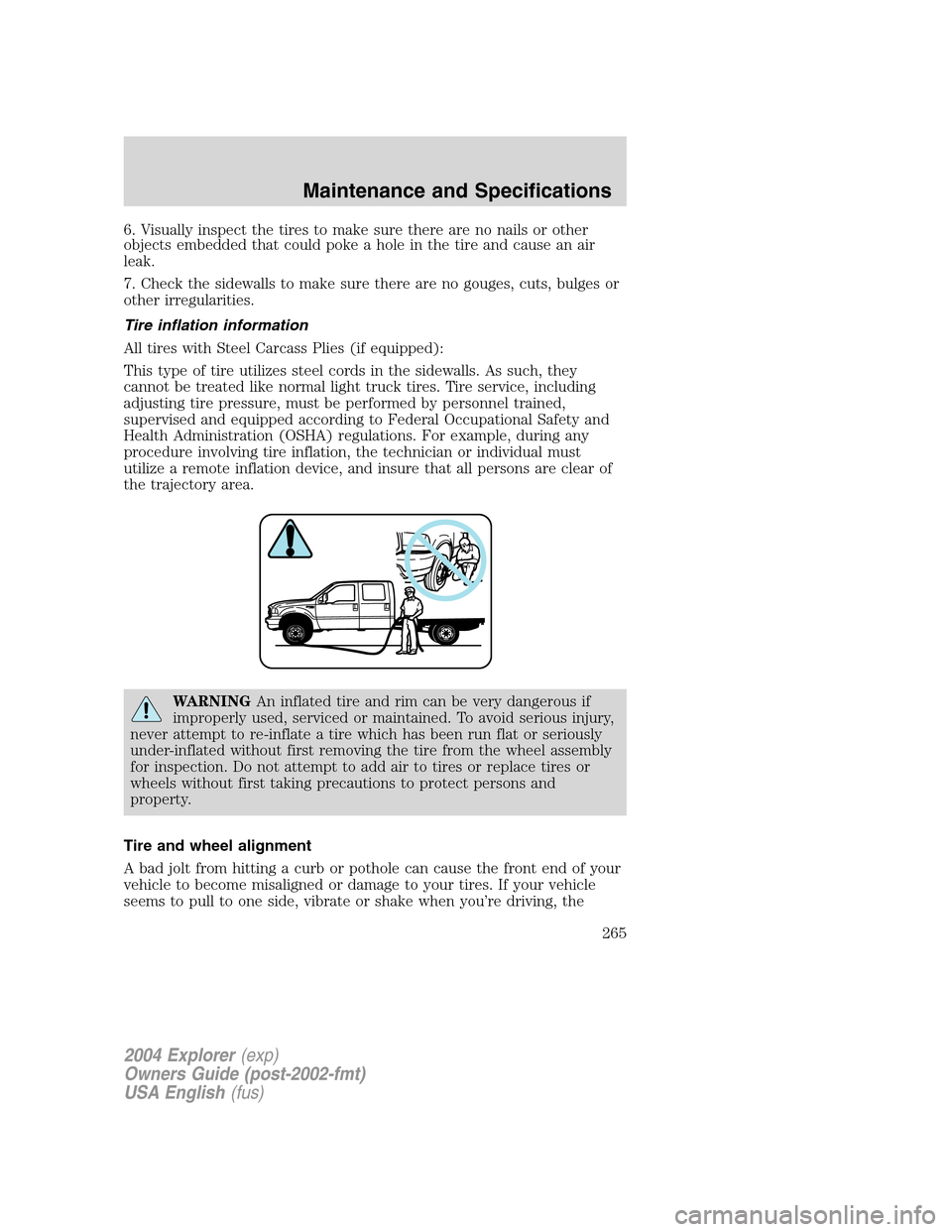
6. Visually inspect the tires to make sure there are no nails or other
objects embedded that could poke a hole in the tire and cause an air
leak.
7. Check the sidewalls to make sure there are no gouges, cuts, bulges or
other irregularities.
Tire inflation information
All tires with Steel Carcass Plies (if equipped):
This type of tire utilizes steel cords in the sidewalls. As such, they
cannot be treated like normal light truck tires. Tire service, including
adjusting tire pressure, must be performed by personnel trained,
supervised and equipped according to Federal Occupational Safety and
Health Administration (OSHA) regulations. For example, during any
procedure involving tire inflation, the technician or individual must
utilize a remote inflation device, and insure that all persons are clear of
the trajectory area.
WARNINGAn inflated tire and rim can be very dangerous if
improperly used, serviced or maintained. To avoid serious injury,
never attempt to re-inflate a tire which has been run flat or seriously
under-inflated without first removing the tire from the wheel assembly
for inspection. Do not attempt to add air to tires or replace tires or
wheels without first taking precautions to protect persons and
property.
Tire and wheel alignment
A bad jolt from hitting a curb or pothole can cause the front end of your
vehicle to become misaligned or damage to your tires. If your vehicle
seems to pull to one side, vibrate or shake when you’re driving, the
2004 Explorer(exp)
Owners Guide (post-2002-fmt)
USA English(fus)
Maintenance and Specifications
265
Page 269 of 296
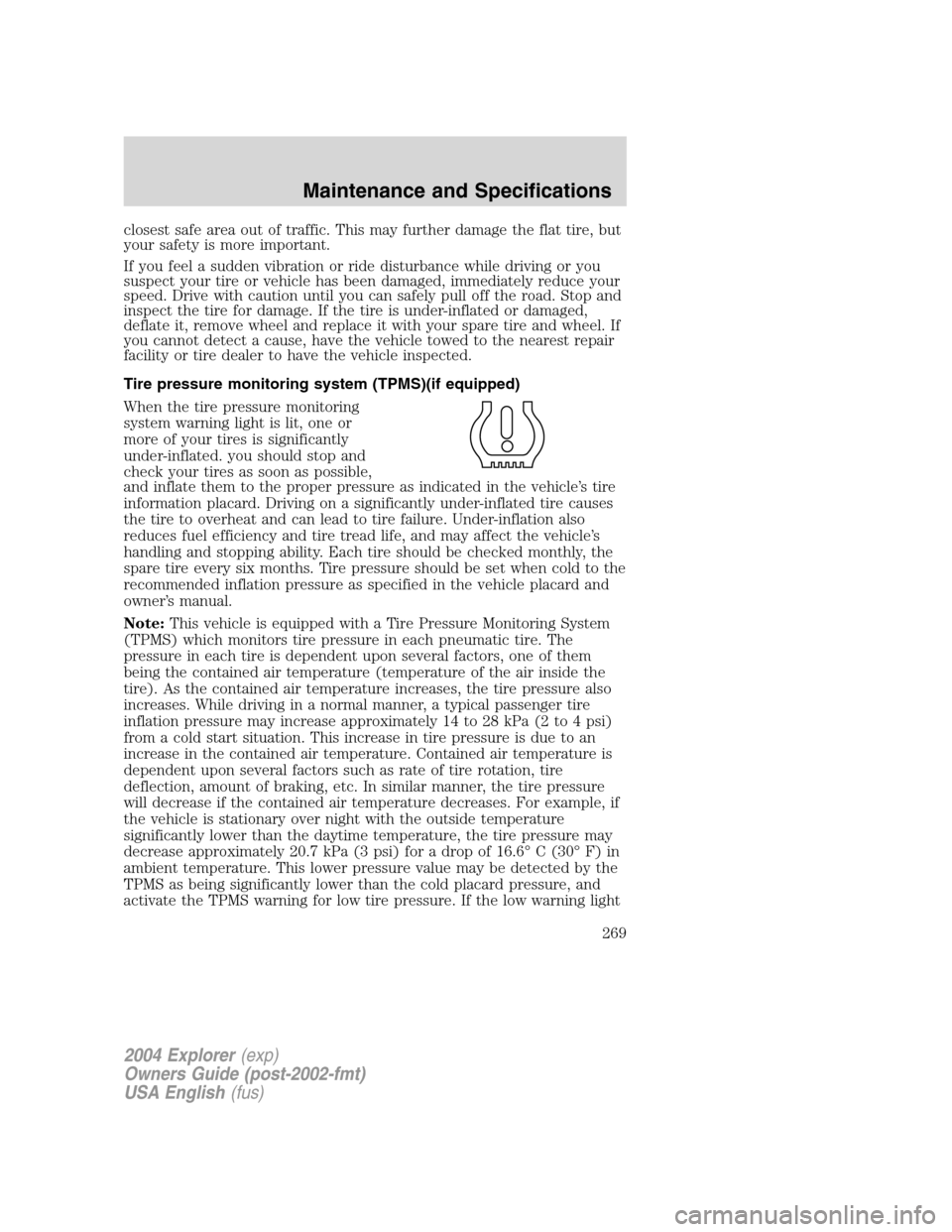
closest safe area out of traffic. This may further damage the flat tire, but
your safety is more important.
If you feel a sudden vibration or ride disturbance while driving or you
suspect your tire or vehicle has been damaged, immediately reduce your
speed. Drive with caution until you can safely pull off the road. Stop and
inspect the tire for damage. If the tire is under-inflated or damaged,
deflate it, remove wheel and replace it with your spare tire and wheel. If
you cannot detect a cause, have the vehicle towed to the nearest repair
facility or tire dealer to have the vehicle inspected.
Tire pressure monitoring system (TPMS)(if equipped)
When the tire pressure monitoring
system warning light is lit, one or
more of your tires is significantly
under-inflated. you should stop and
check your tires as soon as possible,
and inflate them to the proper pressure as indicated in the vehicle’s tire
information placard. Driving on a significantly under-inflated tire causes
the tire to overheat and can lead to tire failure. Under-inflation also
reduces fuel efficiency and tire tread life, and may affect the vehicle’s
handling and stopping ability. Each tire should be checked monthly, the
spare tire every six months. Tire pressure should be set when cold to the
recommended inflation pressure as specified in the vehicle placard and
owner’s manual.
Note:This vehicle is equipped with a Tire Pressure Monitoring System
(TPMS) which monitors tire pressure in each pneumatic tire. The
pressure in each tire is dependent upon several factors, one of them
being the contained air temperature (temperature of the air inside the
tire). As the contained air temperature increases, the tire pressure also
increases. While driving in a normal manner, a typical passenger tire
inflation pressure may increase approximately 14 to 28 kPa (2 to 4 psi)
from a cold start situation. This increase in tire pressure is due to an
increase in the contained air temperature. Contained air temperature is
dependent upon several factors such as rate of tire rotation, tire
deflection, amount of braking, etc. In similar manner, the tire pressure
will decrease if the contained air temperature decreases. For example, if
the vehicle is stationary over night with the outside temperature
significantly lower than the daytime temperature, the tire pressure may
decrease approximately 20.7 kPa (3 psi) for a drop of 16.6° C (30° F) in
ambient temperature. This lower pressure value may be detected by the
TPMS as being significantly lower than the cold placard pressure, and
activate the TPMS warning for low tire pressure. If the low warning light
2004 Explorer(exp)
Owners Guide (post-2002-fmt)
USA English(fus)
Maintenance and Specifications
269
Page 282 of 296

FORD ACCESSORIES FOR YOUR VEHICLE
A wide selection of genuine Ford accessories are available for your
vehicle through your local authorized Ford or Ford of Canada dealer.
These quality accessories have been specifically engineered to fulfill your
automotive needs; they are custom designed to complement the style
and aerodynamic appearance of your vehicle. In addition, each accessory
is made from high quality materials and meets or exceeds Ford’s rigorous
engineering and safety specifications. Ford Motor Company will repair or
replace any properly dealer-installed Ford accessory found to be
defective in factory-supplied materials or workmanship during the
warranty period, as well as any component damaged by the defective
accessory. The accessory will be warranted for whichever provides you
the greatest benefit:
•12 months or 20,000 km (12,000 miles) (whichever occurs first), or
•the remainder of your new vehicle limited warranty.
This means that genuine Ford accessories purchased along with your
new vehicle and installed by the dealer are covered for the full length of
your New Vehicle’s Limited Warranty — 3 years or 60,000 km (36,000
miles) (whichever occurs first). Contact your dealer for details and a
copy of the warranty.
Not all accessories are available for all models.
Following is a list of several Ford Genuine Accessory products. Not all
accessories are available for all models. To find out what accessories are
available for your vehicle, please contact your dealer or visit our online
store at: www.fordaccessoriesstore.com.
Exterior style
Bug shields
Deflectors
Fender flares
Front end covers
Grille inserts
Headlamps, fog lights and Daytime Running Lamps (DRLS)
Running boards
Splash guards
Step Bars
Wheels
2004 Explorer(exp)
Owners Guide (post-2002-fmt)
USA English(fus)
Accessories
Accessories
282
Page 285 of 296
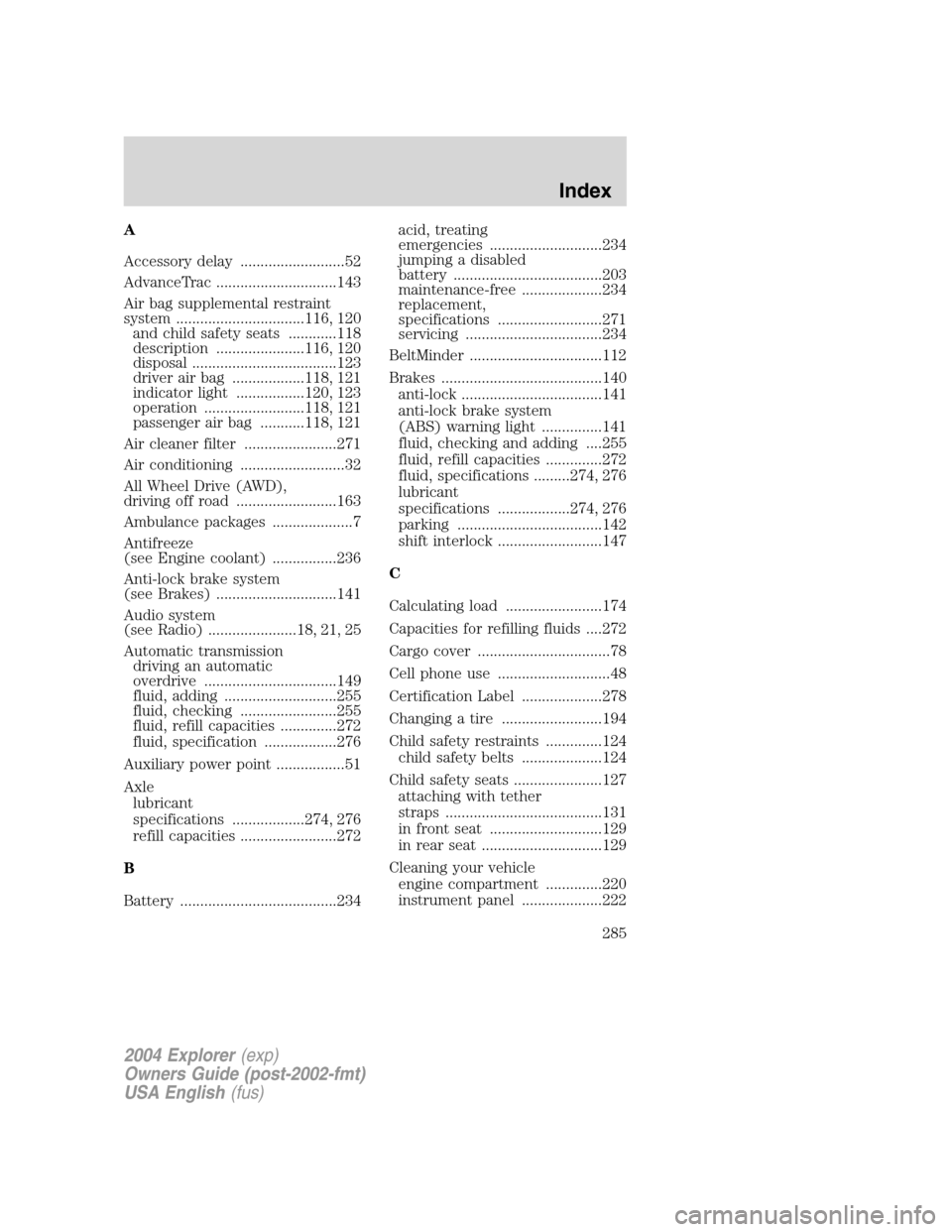
A
Accessory delay ..........................52
AdvanceTrac ..............................143
Air bag supplemental restraint
system ................................116, 120
and child safety seats ............118
description ......................116, 120
disposal ....................................123
driver air bag ..................118, 121
indicator light .................120, 123
operation .........................118, 121
passenger air bag ...........118, 121
Air cleaner filter .......................271
Air conditioning ..........................32
All Wheel Drive (AWD),
driving off road .........................163
Ambulance packages ....................7
Antifreeze
(see Engine coolant) ................236
Anti-lock brake system
(see Brakes) ..............................141
Audio system
(see Radio) ......................18, 21, 25
Automatic transmission
driving an automatic
overdrive .................................149
fluid, adding ............................255
fluid, checking ........................255
fluid, refill capacities ..............272
fluid, specification ..................276
Auxiliary power point .................51
Axle
lubricant
specifications ..................274, 276
refill capacities ........................272
B
Battery .......................................234acid, treating
emergencies ............................234
jumping a disabled
battery .....................................203
maintenance-free ....................234
replacement,
specifications ..........................271
servicing ..................................234
BeltMinder .................................112
Brakes ........................................140
anti-lock ...................................141
anti-lock brake system
(ABS) warning light ...............141
fluid, checking and adding ....255
fluid, refill capacities ..............272
fluid, specifications .........274, 276
lubricant
specifications ..................274, 276
parking ....................................142
shift interlock ..........................147
C
Calculating load ........................174
Capacities for refilling fluids ....272
Cargo cover .................................78
Cell phone use ............................48
Certification Label ....................278
Changing a tire .........................194
Child safety restraints ..............124
child safety belts ....................124
Child safety seats ......................127
attaching with tether
straps .......................................131
in front seat ............................129
in rear seat ..............................129
Cleaning your vehicle
engine compartment ..............220
instrument panel ....................222
2004 Explorer(exp)
Owners Guide (post-2002-fmt)
USA English(fus)
Index
Index
285
Page 287 of 296
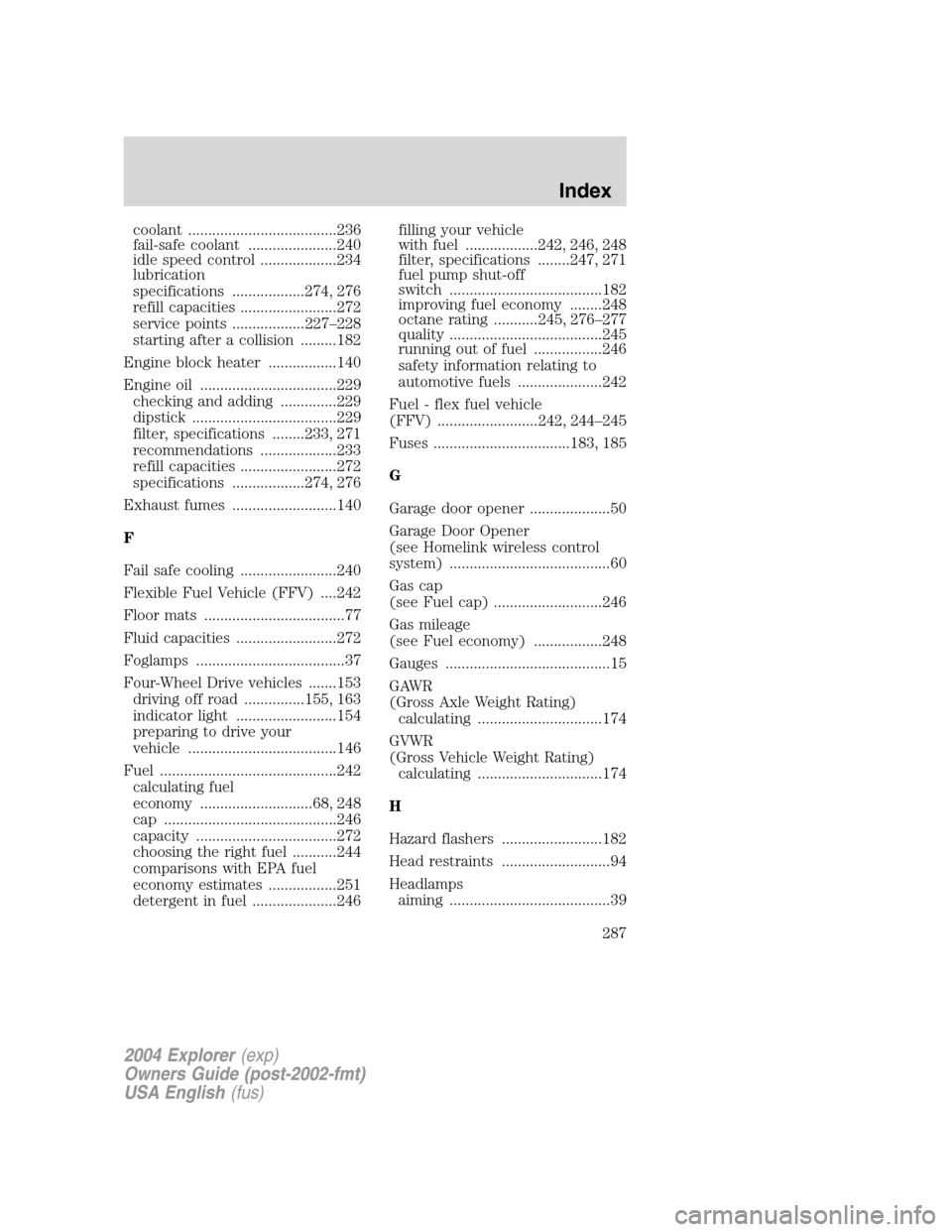
coolant .....................................236
fail-safe coolant ......................240
idle speed control ...................234
lubrication
specifications ..................274, 276
refill capacities ........................272
service points ..................227–228
starting after a collision .........182
Engine block heater .................140
Engine oil ..................................229
checking and adding ..............229
dipstick ....................................229
filter, specifications ........233, 271
recommendations ...................233
refill capacities ........................272
specifications ..................274, 276
Exhaust fumes ..........................140
F
Fail safe cooling ........................240
Flexible Fuel Vehicle (FFV) ....242
Floor mats ...................................77
Fluid capacities .........................272
Foglamps .....................................37
Four-Wheel Drive vehicles .......153
driving off road ...............155, 163
indicator light .........................154
preparing to drive your
vehicle .....................................146
Fuel ............................................242
calculating fuel
economy
............................68, 248
cap ...........................................246
capacity ...................................272
choosing the right fuel ...........244
comparisons with EPA fuel
economy estimates .................251
detergent in fuel .....................246filling your vehicle
with fuel ..................242, 246, 248
filter, specifications ........247, 271
fuel pump shut-off
switch ......................................182
improving fuel economy ........248
octane rating ...........245, 276–277
quality ......................................245
running out of fuel .................246
safety information relating to
automotive fuels .....................242
Fuel - flex fuel vehicle
(FFV) .........................242, 244–245
Fuses ..................................183, 185
G
Garage door opener ....................50
Garage Door Opener
(see Homelink wireless control
system) ........................................60
Gas cap
(see Fuel cap) ...........................246
Gas mileage
(see Fuel economy) .................248
Gauges .........................................15
GAWR
(Gross Axle Weight Rating)
calculating ...............................174
GVWR
(Gross Vehicle Weight Rating)
calculating ...............................174
H
Hazard flashers .........................182
Head restraints ...........................94
Headlamps
aiming ........................................39
2004 Explorer(exp)
Owners Guide (post-2002-fmt)
USA English(fus)
Index
287